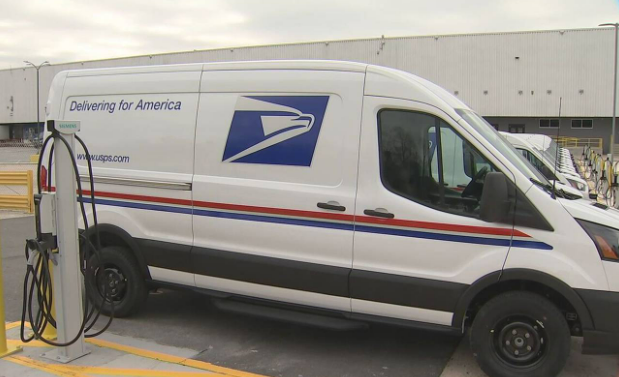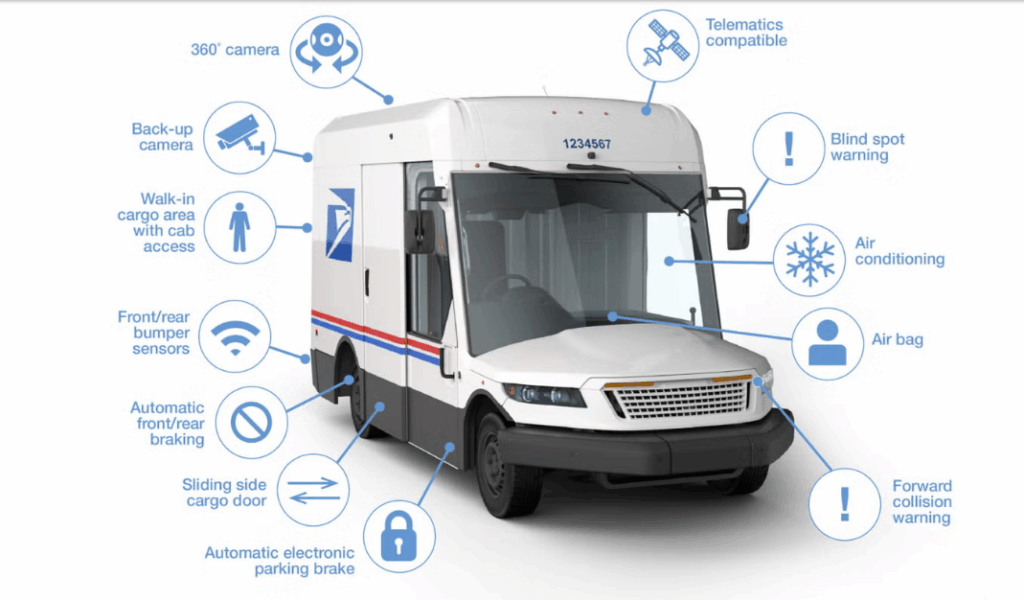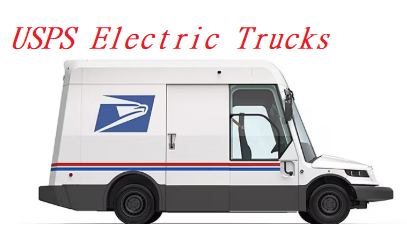Introduction: Evolution of USPS Electric Trucks
The United States Postal Service’s journey toward electrification has been anything but conventional. From drawing attention due to their cartoonish looks to becoming the backbone of Biden’s green transportation push, the USPS Electric Trucks are here to stay—more resilient, sustainable, and equipped than ever.

Key Specifications
- Model: NGDV (Next Generation Delivery Vehicle)
- Battery Range: ~70 to 120 miles (depending on conditions)
- Top Speed: ~75 mph
- Payload Capacity: 2,200 lbs
- Charging: Level 2 AC (with DC fast charging option in future)
- Safety: Automatic emergency braking, backup cameras, lane-keeping assist

U.S. Senate Ruling Makes It Harder to Undo USPS EV Rollout
In a major development for the future of electric mobility within government fleets, the U.S. Senate parliamentarian has ruled that any effort to dismantle the U.S. Postal Service’s existing electric vehicle (EV) plans would now require a supermajority vote. This decision creates a significant hurdle for lawmakers seeking to reverse the USPS’s electrification strategy initiated under the Biden administration.
As it stands, the USPS has already incorporated 7,200 electric vehicles into its national delivery fleet and invested $500 million in EV charging infrastructure. Initially, a new tax and spending bill had included provisions aimed at halting this EV transition. However, the ruling by Senate Parliamentarian Elizabeth MacDonough means that such a move can only proceed with bipartisan support—making abrupt policy reversals far less likely.
The current transition plan calls for replacing the aging 160,000-vehicle USPS fleet with a near 50/50 mix of electric and internal combustion vehicles. However, this ratio is expected to shift entirely in favor of EVs by the end of next year. The plan also includes the procurement of at least 45,000 electric delivery vans built by Oshkosh Defense, along with an additional 10,000 Ford E-Transit vans.
While the Oshkosh Next Generation Delivery Vehicle (NGDV) has received mixed reactions due to its unconventional design, many postal workers appreciate its practicality and modern features. With this new Senate ruling in place, the momentum behind the USPS’s green transition appears not only protected but poised to accelerate.
Top Features That Define the Future
- Modular Architecture: Easily adapted for future upgrades
- Air Conditioning: A first in postal vehicles
- Heated Seats: Designed for harsh winters
- High Roof & Walk-in Cargo Area: Increases efficiency
- Digital Instrument Cluster: Bringing mail delivery into the modern era
Performance and Durability Upgrades
Despite their quirky shape, these trucks are engineered for resilience. The body is reinforced with corrosion-resistant materials, and the drivetrain is optimized to handle frequent starts and stops. With better weight distribution and improved suspension, they’re harder to kill off than ever before.
Design: Quirky Yet Purpose-Driven
Some call them funny-looking, others futuristic. Regardless of opinion, the unusual front grille, tall stature, and oversized windshields are intentionally designed for urban mail routes. The high visibility and roomy interiors help postal workers operate more efficiently—no matter the weather or terrain.
Technology and Sustainability Focus
The USPS fleet’s partial electrification marks a milestone for federal sustainability goals. Equipped with diagnostics software, GPS, real-time route management, and onboard sensors, these trucks are setting new benchmarks.
USPS and Biden’s Green Push
Under the Biden administration, the USPS committed to electrifying 66,000 vehicles by 2028. Funding from the Inflation Reduction Act and pressure from environmental advocacy groups have accelerated the rollout. This aligns with national efforts to reduce federal fleet emissions.
Challenges and Criticism
Despite progress, there has been criticism—mostly over initial hesitancy to go fully electric and the contracts awarded to Oshkosh Defense. Some argue the rollout is too slow, while others worry about battery supply chain issues.
However, the latest models prove that USPS is listening and evolving.
Final Thoughts: Laugh All You Want—They Deliver
The USPS Electric Trucks may never win a beauty pageant, but they’re a powerhouse of practicality. Built for endurance and designed with purpose, they represent more than just mail carriers—they’re a symbol of sustainability wrapped in a quirky shell.
FAQs About USPS Electric Trucks
Q1: Why do USPS electric trucks look so strange?
A: The design prioritizes visibility, cargo space, and ergonomic efficiency over style.
Q2: How long do USPS EVs take to charge?
A: With Level 2 AC charging, a full charge typically takes 6–8 hours. Faster DC charging options are coming soon.
Q3: Are all USPS trucks going electric?
A: No, but by 2028, 66,000 vehicles are expected to be electric.
Q4: Who builds these USPS EVs?
A: Oshkosh Defense is the primary contractor behind the NGDV platform.
Q5: Will they be used in rural areas?
A: Yes, but rollout will begin in urban centers where stop-and-go traffic makes EVs most efficient.

